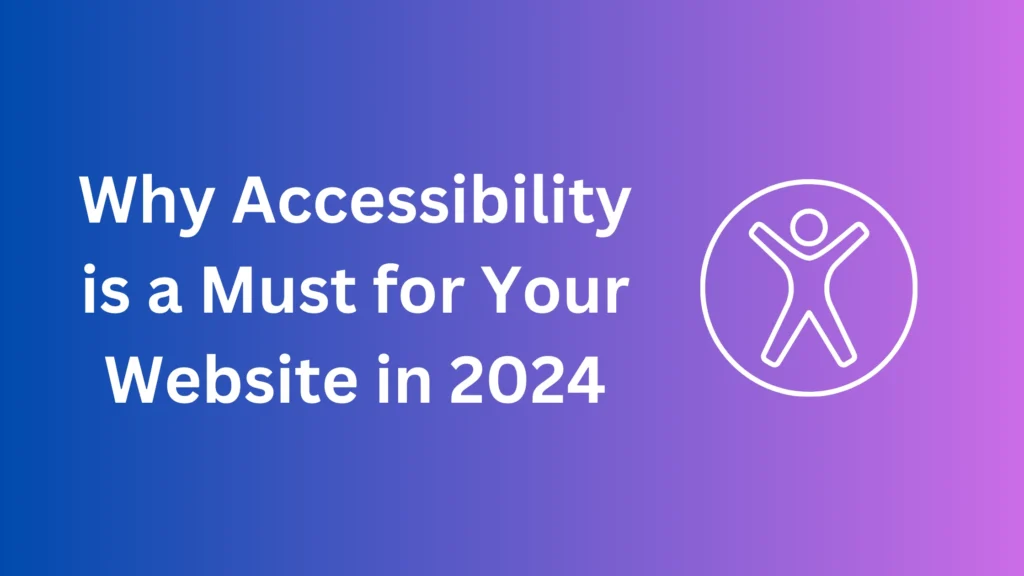Did you know that 1 in 4 people live with some form of disability? Ensuring your website is accessible isn’t just the right thing to do—it’s good for business. Here’s why accessibility matters:
Broader Audience Reach
An accessible website allows everyone, including people with disabilities, to interact with your content. Disabilities can include visual impairments, hearing difficulties, motor challenges, and cognitive disabilities. By making your site accessible, you ensure that a larger audience can engage with your business.
Think about it this way: if your website isn’t accessible, you could be excluding 25% of potential users. Imagine if those users were unable to navigate your website, read your content, or make purchases simply because of design or functionality barriers. Ensuring accessibility can significantly increase your potential audience and create a more inclusive user base.
Key features that improve accessibility include:
- Text alternatives (alt text) for images, so users with visual impairments can understand your content through screen readers.
- Transcripts or captions for video content, enabling users with hearing impairments to access the same information.
- Keyboard navigation, which allows users who can’t use a mouse to fully engage with your site.
By optimizing for accessibility, you expand your reach and welcome everyone into your digital space.
Legal Compliance
With growing awareness and regulation around web accessibility, many countries and regions have made compliance a legal requirement. In 2024, failing to meet accessibility standards can expose your business to legal risks, including fines or lawsuits.
The Web Content Accessibility Guidelines (WCAG) 2.1 are widely accepted as the standard for web accessibility. These guidelines cover a range of criteria, such as making content perceivable, operable, understandable, and robust. Meeting these standards helps you avoid costly legal battles and ensures that your website complies with both local and international accessibility laws.
Regions like the United States, the European Union, Canada, and Australia have strict regulations when it comes to web accessibility. For example, in the U.S., businesses that fail to meet the Americans with Disabilities Act (ADA) standards can face legal challenges.
Tip: Conduct an accessibility audit of your site to identify and fix any potential barriers. It’s much more cost-effective to address accessibility upfront than to face legal consequences later.
SEO Benefits
Believe it or not, accessibility can give your SEO a much-needed boost. Accessible websites often have cleaner code, better structure, and improved content organization—all factors that search engines love. This means that making your website inclusive can also enhance your visibility on platforms like Google.
Here are a few accessibility practices that can positively impact SEO:
- Alt text: Search engines can’t “see” images, but they can read alt text, which helps them understand what’s in the image. Adding descriptive alt text not only improves accessibility but also makes your images more discoverable in search results.
- Proper heading structure: Screen readers use heading levels (H1, H2, etc.) to help users navigate content. Properly structured headings make your content easier to consume for both users and search engine crawlers.
- Mobile-friendly design: Many accessibility features, like responsive design and simple navigation, improve the mobile experience—something Google increasingly prioritizes.
By enhancing your site’s accessibility, you’re also enhancing your search engine ranking potential, driving more organic traffic to your website.
Improved User Experience
Accessibility isn’t just about serving users with disabilities—it’s about creating a better experience for all users. Many of the features designed to improve accessibility also make your website more intuitive, user-friendly, and easy to navigate for everyone.
For example, alt text helps people using screen readers, but it also benefits anyone experiencing slow internet speeds, as they can still get context even if images fail to load. Similarly, captioning on videos makes content available to those with hearing impairments, but it also helps people watching videos in noisy environments or when they can’t turn on sound.
Accessibility improves:
- Navigation: Features like keyboard navigation and clear focus indicators make your site easier for everyone to navigate.
- Clarity: Color contrast guidelines and scalable fonts improve readability for all users, especially those with visual impairments or age-related sight issues.
- Interaction: Ensuring that all interactive elements (like buttons and forms) are easy to access and use benefits everyone, including people with temporary disabilities like a broken arm or new parents juggling a baby.
A positive user experience leads to higher engagement and better conversion rates, making accessibility a key factor in improving your bottom line.
Conclusion: Is Your Website Inclusive?
As we move deeper into 2024, accessibility is no longer negotiable. It’s essential for reaching a broader audience, complying with legal requirements, improving SEO, and enhancing the overall user experience.
By making your website inclusive, you’re not just checking off a legal requirement—you’re creating a welcoming, functional, and user-friendly space for everyone, no matter their abilities. So, is your website inclusive?
If you’re unsure where to start with improving accessibility on your website, let’s connect and ensure your site is ready for the future.

